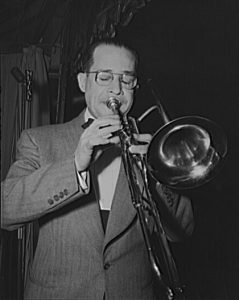Caravan, composed by Juan Tizol and Duke Ellington, is the most covered jazz standard in history, with more than 500 covers. But what does this song represent?
The Jones-Shafroth Act of 1917 granted US citizenship to Puerto Ricans, which led to a surge of Puerto Ricans immigrating to the US, especially to New York through Ellis Island. Many Puerto Rican musicians were recruited, due to their talent and ability to read music, to play in jazz clubs and theater pit bands in Washington D.C. and New York, primarily catering to black audiences. “Circa 1920, except for the leader, the entire pit orchestra of the legendary Howard Theater in Washington was composed of Puerto Rican musicians, and it included Tizol” (Serrano 90). In an interview with Patricia Willard in 1978, Juan describes his experience moving to the United States in 1920, working factory jobs in New York in order to save enough money to buy an instrument and make a living. He eventually encountered Duke Ellington when he went to Howard Theatre in Washington D.C. several years later. The experiences of Puerto Rican immigrants during this time is often characterized by poverty, hardship, and racial discrimination, and it is important that this is not overlooked, especially when considering the vital role that Puerto Rican jazz musicians contributed to the cultural production of an American genre. Juan Tizol was a composer and played trombone in Duke Ellington’s Big Band from 1929 to 1953. Tizol was born in San Juan, Puerto Rico in 1900, and came to the United States in 1920 with some musicians he was playing with in a Puerto rican municipal band at the time. Many Puerto Rican musicians would travel between New York and Puerto Rico, since there weren’t very many opportunities to perform jazz on the island at the time, and it was emerging more prominently in places like New Orleans and New York. Others were recruited to play in the Harlem Hellfighters during WWI. It is important for us to recognize the role that Puerto Rican musicians played in developing jazz, as they were intentionally intertwined in the jazz music scene during a time of intense cultural production.
Considering this, It was interesting to read that Tizo’s compositions fell under the genre of “exotica”, which is characterized by ideas of “distant, mythical and mystical lands” (Serrano 89). It was also mentioned that Tizo had originally included “Porto Rico”* in the title of several of his compositions, including “Porto Rican Girl” dedicated to his sister Remedio. Before publishing, the title was changed to “Moon Over Cuba” since she had moved to Cuba… While there is no definitive reason for this change, it is interesting to consider the narrative of distance and otherness that is preserved in the edited titles of his songs. ‘Porto Rico’ was included in several other of Tizo’s original titles, but were changed before they were published. What is demonstrated by the intentions to separate Puerto Rican identity from Tizol’s compositions? Does it give us insight on the marketing strategies during the time? Is it reflective of the attitudes towards Puerto Rican citizens living in the United States? When considering an American genre such as jazz, it is important to recognize all of the musicians that contributed to the narrative of the art, and the circumstances that they endured. What does this reflect about the narrative that has been created about American music, and who is included in it?
*In the Treaty of Paris in 1898 they changed the name of Puerto Rico to ‘Porto Rico’, in efforts to make it easier to pronounce for Americans. It wasn’t until 1932 that they changed it back to the original spelling and the spelling they always had used on the island.
Serrano, Basilio. “Juan Tizol: His Talents, His Collaborators, His Legacy.” Centro Journal 18, no. 2 (2006): 82–99.
Juan Tizol oral history interview. Retrieved from https://doi.org/doi:10.7282/t3-3r99-0749

